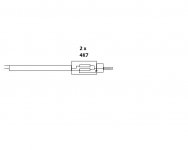The only drawback with using this approach is that you will introduce noise into the amplifier, not much but a bit and the line input may be more susceptible to noise pick-up.
The preferred way to do it is with an attenuator.
This time the resistors need to be in the order of 10x smaller than the input impedance of the amp.
Replace the 47K with 4K7 and wire another 4K7 between the pin of the RCA and the body of the RCA. (The second 4K7 is then across the input of the amplifier).
The resistor values aren't critical, you could equally well use 2K2.
The preferred way to do it is with an attenuator.
This time the resistors need to be in the order of 10x smaller than the input impedance of the amp.
Replace the 47K with 4K7 and wire another 4K7 between the pin of the RCA and the body of the RCA. (The second 4K7 is then across the input of the amplifier).
The resistor values aren't critical, you could equally well use 2K2.
Attachments
Last edited:
The preferred way to do it is with an attenuator.
...or voltage divider, which is exactly what I said in post #56.
Sorry couldn't resist. 😉
- Status
- Not open for further replies.
